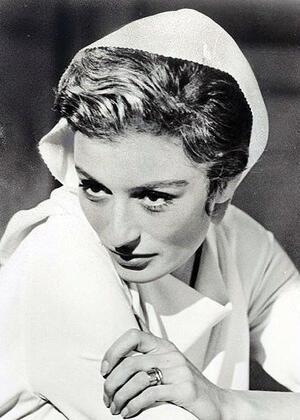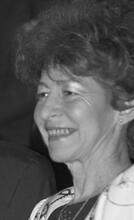Anouk Aimée
Publicity photo of French actress Anouk Aimee in 1963 for 8 1/2.
Image courtesy of Embassy Pictures via Wikimedia Commons.
French actress Anouk Aimée studied acting and ballet in Paris, London, and Marseilles. She began acting at fourteen; during the 1980s and 1990s, when other actresses had difficulty finding roles for “mature” women, she made a film a year. Aimée’s career can be roughly divided into three phases—the early arthouse avant-garde of the 1950s and 1960s, in which she defined a new kind of modern heroine; the period of international stardom; and the phase of the committed woman, less concerned with screen presence than with using her position to make a difference in the world. Aimée dramatized her identity as a Jewish woman affected by the burden of history in her 2002 role as a Holocaust survivor returning to Auschwitz in La Petite prairie aux bouleaux.
Overview
Anouk Aimée is perhaps best known for her remarkable presence as an icon of cool, sophisticated beauty in more than seventy films across seven decades, including such classics as Alexandre Astruc’s Le Rideau Cramoisi (The Crimson Curtain, 1952), Federico Fellini’s La Dolce Vita (1960) and 8 1/2 (1963), Jacques Demy’s Lola (1961), André Delvaux’s Un Soir, un Train (One Evening, One Train, 1968), George Cukor’s Justine (1969), Bernardo Bertolucci’s Tragedy of a Ridiculous Man (1981), Robert Altman’s Prêt à Porter (Ready to Wear, 1994), and, most unforgettably, Claude Lelouch’s Un Homme et une femme (A Man and a Woman, 1966) opposite Jean-Louis Trintignant—a film that virtually reignited the lush on-screen romance in an era of skeptical modernism. Words like “regal,” “intelligent,” and “enigmatic” are frequently associated with her, giving Aimée an aura of disturbing and mysterious beauty that has earned her the status of one of the hundred sexiest stars in film history (in a 1995 poll conducted by Empire Magazine).
Aimée’s striking features are known to many who have never seen her films. The much-vaunted comparison with Jacqueline Kennedy is more than physical; film historian Ginette Vincendeau notes that Aimée’s films “established her as an ethereal, sensitive and fragile beauty with a tendency to tragic destinies or restrained suffering” (Ginette Vincendeau, The Companion to French Cinema, BFI 1996).
Jewish Identity
While little had been known of her Jewish background, Anouk Aimée brilliantly dramatized her identity as a Jewish woman affected by the burden of history in her 2002 role as a Holocaust survivor returning to Auschwitz, in Marceline Loridan’s feature film directorial debut, La Petite prairie aux bouleaux (The Little Meadow of Birch-Trees, 2002). Aimée was herself only a young girl during the German occupation of France and the Vichy regime, each with its specific program of antisemitic persecution, making her a good fit for Loridan’s autobiographical work (Loridan was a fourteen-year-old inmate of Auschwitz). At the New York City screening of the film in the spring of 2003, Aimée was still reticent about her own life during the war (she referred to a relative who had been deported and killed but stopped short of saying what she herself experienced), yet she spoke with eloquence and animation about the importance of documenting this chapter of Jewish history.
Family and Education
Anouk Aimée was born Nicole Françoise Florence Dreyfus on April 27, 1932, in Paris. Both her parents were actors; her mother, Geneviève Sorya, was not Jewish, but her father, Henry Dreyfus (who used the name Henry Murray professionally and may have been connected to Captain Alfred Dreyfus), was. Aimée is notoriously private about her personal life and history. She was referred to variously as Françoise Sorya, Françoise Dreyfus, or Nicole Dreyfus until her acting career (begun when she was just fourteen, with a role in Henri Calef’s La Maison sous la mer [The House by the Sea, 1947]) earned her the name by which she is known. At first she was simply Anouk, taken from the character she played in Marcel Carné’s unfinished film La Fleur de l’âge (The Flower of the Age); it was the poet Jacques Prévert, writing André Cayatte’s Les Amants de Vérone (The Lovers of Verona, 1949) specifically for her, who playfully added the symbolic last name that would forever associate her with the affective power of her screen roles.
Already talented as a child, Aimée studied acting and ballet in Paris, London, and Marseilles; her training in dance at the famous Bauer-Therond school prepared her for future roles as a performer in such films as Lola and The Model Shop (1969), two films by Jacques Demy that solidified her haunting screen presence that dominated the narrative. The former film has become legendary for its ephemeral grace and power, largely due to her performances and the elusive beauty that captivated audiences in a film that has only the slimmest of narratives.
Performing Career
Anouk Aimée made films all her life; during the 1980s and 1990s, when other actresses had difficulty finding roles for “mature” women, she made one film a year, and she continued well into the twenty-first century. (“You can only perceive real beauty in a person as they get older,” she said in 1988.)
In 2003 Aimée was awarded an honorary Golden Bear at the Berlin Film Festival, where she used the opportunity to step out of her role as star to advocate for peace “for the children of the world.” Even though she has been referred to as “ageless,” “a legend,” and “a goddess of cinema mythology,” quite possibly her role in The Little Meadow of Birch-Trees, so close to her own experience as a Jewish woman who comes to terms with her wartime past, contributed to the way she came to see herself, as an icon of world peace and reconciliation rather than the enigmatic diva of the European art cinema.
Aimée’s career can be roughly divided into three phases—the early arthouse avant-garde of the 1950s and 1960s, in which she defined a new kind of modern heroine; the period of international stardom, initiated by the Academy Award nomination and Best Foreign Film award and the Golden Globe for Un Homme et une femme and marked by work with many of world cinema’s most talented directors; and the phase of the committed woman, still beautiful but less concerned with screen presence than with using her position and her fame to make a difference in the world. Her three marriages loosely correspond to these time periods; she was briefly married to director Nikos Papatakis (1951–1954), then to composer Pierre Barouh (Baruch) from 1966 to 1969 (who appeared with her when she received the Golden Globe for Un Homme et une femme), and finally to actor Albert Finney (1970–1978), when she seems to have semi-retired from acting for a while. The twenty-first century saw Aimee continue her acting, but at a slower pace. In 2019, she rejoined director Claude Lelouch and actor Jean-Louis Trintignant in The Best Years of a Life, which revisited A Man and a Woman but with limited success. She received several awards, including the Honorary Cesar (2002), the Honorary Golden Bear at the Berlin International Film Festival (2003), and a cinematic tribute to her career at the Cinemania Film Festival in Montreal (2013). She acted in maternal roles in 2003 (Happily Ever After), 2010 (Paris Connections), 2011 (Tous les soleils), and 2012 (Mince Alors).
But it was as a single woman for the last several decades of her life that Aimée solidified her reputation both as a major actress with international appeal and as a champion of human rights. She lived in the Montmartre section of Paris with her daughter Manuela, continuing to demonstrate her “distinctive combination of melancholy and passion” in films that matched the intensity of her beauty with the complexity of mature roles.
Anouk Aimée died on June 18, 2024.
SELECTED FILMOGRAPHY
La Maison sous la mer, 1947.
Les Amants de Vérone, 1948.
Le Rideau Cramoisi, 1952.
Montparnasse 19 (Modigliani of Montparnasse), 1957.
Pot-Bouille, 1957.
La Tête contre les murs, 1959.
La Dolce Vita, 1959.
Lola, 1961.
8 ½, 1963.
Un Homme et une femme, 1966.
The Model Shop, 1968.
Un Soir un train, 1968.
Justine, 1969.
The Appointment, 1969.
Salto nel vuoto, 1979 (A Leap in the Dark).
Tragedy of a Ridiculous Man, 1981.
Vive la vie, 1984.
Bethune: The Making of a Hero, 1990.
Prêt-à-porter, 1994.
Cent et une nuits de Simon Cinéma (A Hundred and One Nights), 1995.
Hommes, femmes, mode d’emploi (Men, Women: A User’s Manual), 1996.
Festival in Cannes, 2001.
Petite prairie aux bouleaux, 2002.
Ils se marièrent et eurent beaucoup d’enfants (Happily Ever After) 2003.
Television
“Une Page d’amour” (A Page of Love), 1980.
“Fernanda,” 1988.
“Mon dernier rêve sera pour vous” (My Last Dream Will Be for You), 1989.
“Voices in the Garden,” 1993.
“Solomon,” 1997.
“L’île bleu,” 2001.
“Napoleon,” 2002.
As Herself
“Victoire, ou la douleur des femmes” (Victory, or the Grief of Women, TV miniseries), 2000.
L. A. Without a Map, 1998.
L’Univers de Jacques Demy (The World of Jacques Demy), 1995.
La Table tournante (The Revolving Table), 1988.
Portrait de Vittorio Gassman (television), 1979.
Guest Television Appearances
“Les Feux de la rampe” (Footlights), 2001.
“Tout le monde en parle” (Everybody’s Talking about It), 1998.





